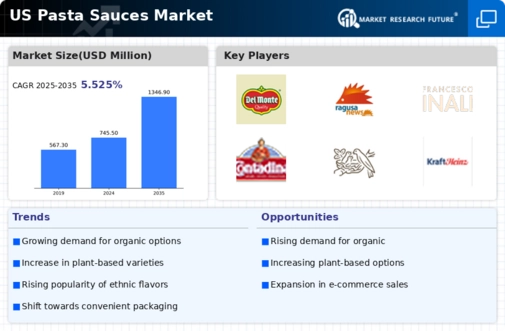Health and Wellness Trends
The pasta sauces market is being influenced by the growing health and wellness trends among consumers. As individuals become more health-conscious, there is a rising demand for sauces that are lower in sugar, sodium, and artificial ingredients. This shift is prompting manufacturers to reformulate their products to meet these evolving consumer preferences. Recent data shows that sales of organic and health-oriented pasta sauces have increased by around 18% in the last year, indicating a clear market trend. As health and wellness continue to be prioritized, the pasta sauces market is likely to adapt, offering a wider range of healthier options to cater to this demographic.
Growth of E-commerce Channels
The expansion of e-commerce platforms is significantly impacting the pasta sauces market. With the increasing preference for online shopping, consumers are now able to access a wider variety of pasta sauces than ever before. This shift has been accelerated by advancements in technology and logistics, allowing for faster delivery and improved customer experiences. Recent statistics suggest that online sales of pasta sauces have increased by over 20% in the past year, reflecting a broader trend towards digital retail. As more consumers turn to online channels for their grocery needs, the pasta sauces market is likely to see continued growth in this segment, prompting brands to enhance their online presence.
Emergence of International Flavors
The pasta sauces market is witnessing a rise in the popularity of international flavors, as consumers become more adventurous in their culinary choices. This trend is characterized by an increasing interest in sauces inspired by global cuisines, such as Asian, Mediterranean, and Latin American. The incorporation of diverse flavors is appealing to a broad demographic, particularly among younger consumers who seek unique dining experiences. Market analysis indicates that sauces featuring international flavors have seen a growth rate of approximately 12% over the past year. This diversification of flavor profiles is likely to continue shaping the pasta sauces market, encouraging brands to innovate and expand their offerings.
Rising Demand for Authentic Flavors
The pasta sauces market is experiencing a notable increase in demand for authentic and traditional flavors. Consumers are increasingly seeking products that reflect genuine culinary heritage, which has led to a surge in sales of artisanal and gourmet sauces. This trend is particularly pronounced among millennials and Gen Z, who prioritize quality and authenticity in their food choices. According to recent data, the market for premium pasta sauces has grown by approximately 15% annually, indicating a shift towards higher-quality offerings. This rising demand for authentic flavors is driving manufacturers to innovate and expand their product lines, thereby enhancing the overall competitiveness of the pasta sauces market.
Increased Focus on Sustainable Packaging
Sustainability is becoming a critical consideration in the pasta sauces market, with consumers increasingly favoring products that utilize eco-friendly packaging. This shift is driven by a growing awareness of environmental issues and a desire to reduce plastic waste. Brands that adopt sustainable packaging solutions are likely to attract environmentally conscious consumers, thereby enhancing their market position. Recent surveys indicate that approximately 70% of consumers are willing to pay a premium for products that are packaged sustainably. As a result, manufacturers are investing in innovative packaging technologies, which could lead to a transformation in the pasta sauces market, aligning product offerings with consumer values.























Leave a Comment